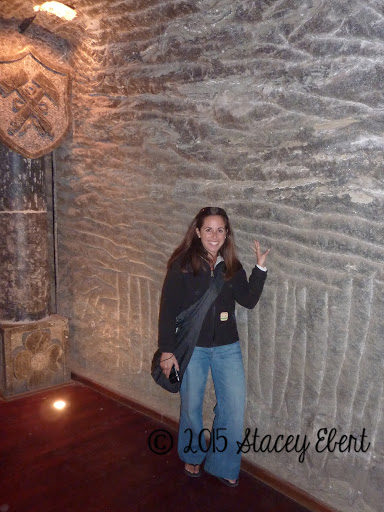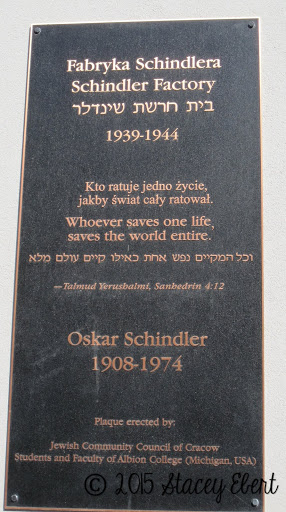I had friends in high school that traveled to Eastern Europe, family who emigrated, and a history shared with millions. It’s been a place ‘on my list’ for the longest time, so when the opportunity arose, we jumped on it. Tenth graders in New York schools learn about life in Eastern Europe during, before, and after the Holocaust. Eleventh graders touch on life and politics, but focus more on America’s entrance into World War II. But for many of us, where our hands and feet wander is what we remember. More than a page in a book, more than an image on a screen, more than a lecture heard –first hand experience sticks with you. Poland was no different.
I entered Poland as I wish for students to enter a classroom. There were wide eyes, open ears and mind, a little bit of knowledge, and an eager thirst for more. Now of course, as educators, it would be nice if that was always the case, but let’s be realistic, right? A lot of kids have other things on their minds, obstacles in their way, struggles about which no one knows, or an interest in something other than your subject matter. If we can hook them somehow each day, or most days, it’s a win and perhaps that next day they and you will learn something together that hadn’t been touched on the day prior. Even before I crossed the border, I was ready to be there.
Krakow was our first city. Oozing with history in sights, culture, and architecture, our first stop was the former Jewish Quarter. Still maintaining an active synagogue, the area is filled with memorials, mementos, and monuments to lives lost during the Holocaust. Students interested in probing further into Judaism, discussing historical events, or just taking in the lives of those living here today will find the area mystifying, gratifying, and a bit surreal. Continuing through the former Jewish Quarter, one of the memorials is exceptionally striking. In an area just off the street is a set of what seems to be randomly placed chairs. Some are next to each other in a row, while others standalone. As one of Krakow’s Holocaust memorials, this somber, quiet tribute to the millions killed leaves onlookers pensive and introspective, while many find it difficult to capture the words to describe the feelings experienced. This is that extra component that can’t exist in a classroom. At times we are able to come close to replicate a time or a place, but this added emotional element is attainable only in person.

Many Eastern European cities center on an Old Town. While the area and architecture are straight out of another time, new stores and restaurants have arrived to add a bit of today to yesteryear. Still, here is where you find hawkers and buskers of all kinds. Here is where you find market stalls filled with Amber, the stone synonymous with Poland. Here is where you find alleyways to wander off and taste traditional pierogis while taking in the sights and sounds of Krakow. Here, in the town square, sharing footsteps with decades of others and those who are yet to arrive, here all of the senses are heightened and one can experience the essence of Poland.

Krakow is home to the UNESCO Salt Mines. The underground mines, completely made of grey salt (not like your white table salt) are covered in ornate sculptured figures. Miners who spent hours, days, and even years underground created intricate detailed chapels, temples, and lifelike figures. Amidst the architecture and artistry of the mines, labour of its workers and years in its history, science prospers. The salt-laden crisp, cool air is allegedly fabulous for allergy and asthma sufferers. In the name of research, active scientists might want to uncover as much information as possible. It’s altogether possible that they might decide to taste the walls in homage to Willy Wonka’s lick-a-wall-paper. Who would get in the way of a budding researcher at work?


Poland’s history is synonymous with World War II and The Holocaust. We spent just over three hours at the concentration camps of Auschwitz and Birkenau. Hardly are there words able to do justice to the emotions flooding through ‘guests’ that day and as always, each individual brings his/her own history to the visit experiencing its weight differently. A tour of this hallowed ground takes visitors through the horrors and atrocities that unfolded in this gruesome place at a terrible time.

With headsets to hear, your guide leads you through a woven history of palpable suffering, heartache, unmentionable atrocities, and incredible emotion. Around every corner, eyes well with tears as another story is told of a life taken. Our guide, Agnes, told us her grandmother made her work there to remember. Her family, amidst having their homes destroyed and being taken to the camps, survived. Agnes is a living legacy who shares theirs and others’ stories daily. She provides the real life primary source documents students tend to study. The final stop is a memorial created by survivors with plaques in twenty-two different languages and an English one added for many of those coming to visit Auschwitz today. Although your heart feels as if it’s being ripped from your chest and all you can see is suffering, being there is immensely important. Remembering, honouring, teaching, sharing, and retelling the stories allow history to not repeat and memories to live on. Amidst death and destruction, there is life. Butterflies soared past us at the memorial showing signs of life today. If that’s not a teachable moment, I don’t know what is.
Warsaw is different than Krakow. Renowned for historical images and the works of Chopin (considered to be Poland’s greatest composer), Warsaw is a city all its own. Lazienki Park (pronounced Wazchenskee) showcases a sculpture of Frederic Chopin for all to see as they wander the park daily. This old city wears its history and heart on its proverbial sleeve. Passing the area of the former Warsaw Ghetto, history overpowers. Throughout the city, there are remnants of an earlier time. Old architecture, war-torn buildings, the second oldest university in Poland (from 17th century…the first oldest, from the 13th century is in Krakow), and oddly enough, a palm tree, erected overnight, which today stands as a symbol of Krakow and of course, a conversation piece for visitors, all take their place in the city. Venturing through various areas, a massive stone monument to members of the Warsaw uprising (when they tried to fight for control of the city) stands tall over all who pass by. Surrounded by flags, flowers, and mementos placed by visitors, it’s hard not to feel the past in the present.

Our tour ended in Old Town, but this old town was different. This square had been almost completely turned to rubble during World War II and the citizens of Poland, (who were few and far between since many were murdered by the Nazis) rebuilt their town using drawings and pictures to make it look exactly as it had before the terror. As in other town squares or centers, plazas, piazzas, and such, old and new worlds collide. The accents, dress, religion, politics, and food of old mix with that of the young, vibrant, new, and foreign for a cacophony of sounds and smells unlike any other. The amalgamation creates the town of today while building on blocks of the past and keeping its lessons in tact.
Poland embodies the Eastern European lifestyle. Budding scientists can see the house where Madame Curie was born. Blossoming musicians and symphony aficionados can get a glimpse of concert pianists revisiting Chopin’s works. Burgeoning culinary artists can learn the art of pierogi making and other classic dishes from renowned chefs. Developing historians can study life before, during, and after the war to understand Poland’s past, present, and future. Rising human rights activists will want to visit the factory of Oskar Schindler to see how one man saved the lives of so very many. Emerging sociologists will continue to find similarities and differences in Poland’s culture as analysis ensues.

There are students who take interest in history just because. There are those who struggle to find the magic in the subject at all, and still those who manage to pinpoint a few topics that ignite the spark to dig further. Travel is no different. Educational travel, whether packaged that way or a journey that becomes an education in some way or another, has similar components. Poland’s cities merge all. With its nod to the past and fervor towards the future, this country of old is new again. Self – help guru Wayne Dyer says ‘When you change the way you look at things, the things you look at change." Perhaps that’s what we want for our students. Ignite the spark, wander through the journey, fight to persevere, and thrive to explore further into a pathway all your own. This is Poland. Her cities, people, and culture have much to offer. From old worlds to new, from culinary classics to nouveau cuisine, from a history of destruction to embracing life anew…Poland is worth the visit.
Stacey Ebert, our Educational Travels Editor, is a traveler at heart who met her Australian-born husband while on a trip in New Zealand. Stacey was an extracurricular advisor and taught history in a Long Island public high school for over fifteen years, enjoying both the formal and informal educational practices. After a one year 'round the world honeymoon, travel and its many gifts changed her perspective. She has since left the educational world to focus on writing and travel. She is energetic and enthusiastic about long term travel, finding what makes you happy and making the leap. In her spare time she is an event planner, yogi, dark chocolate lover, and spends as much time as possible with her toes in the sand. Check out her website at thegiftoftravel.wordpress.com for more of her travel musings.
All photos courtesy and copyright Stacey Ebert
